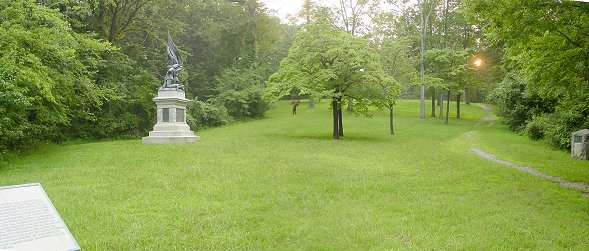
Chickamauga

Thomas HQ Near Snodgrass House
Harker's brigade fell back to here, Snodgrass Hill, and formed two lines roughly parallel to the monuments on the ridgetop on the right of the picture. The first line on the crest would fire, then was replaced by a line moving from the protection of the rear of the hill. Other Union units joined the defense. The corps of George Thomas, a Virginia Unionist, was not swept up in the panic and stubbornly defended Snodgrass Hill. Thomas made his headquarters in the low ground on the left of the picture.

Horseshoe Ridge - Confederate View
The additional Union troops extended the line from Harker's position, just up the road in the center of the position, to Horseshoe Ridge, the eminence in the left-center of the picture. As more Federals arrived, the extended down the ridge. Confederates of Kershaw's division attacked near here, and the attacking Confederate line extended down Vittatoe Road, visible on the left of the picture.

Horseshoe Ridge
Arriving Union troops extended the line along Horseshoe Ridge, with the line facing to the left of the picture. The Union troops on Snodgrass Hill and Horseshoe Ridge held, and total disaster was averted.
Polk's Wing of the Confederate army did not keep up the pressure on his front, and the remaining Union units remained on the field until 5:30 P.M., when they were ordered to withdraw. The battle cost 18,000 Confederate casualties out of the 66,000 man army. The Union army lost 16,000 of its 58,000 men.
Gen. Bragg did not pursue the disorganized Union army, and when the Confederates reached Chattanooga, they settled into a siege instead of storming or bypassing the city. The last great opportunity to destroy a Union army was lost. This had been the Confederacy's last great hope.